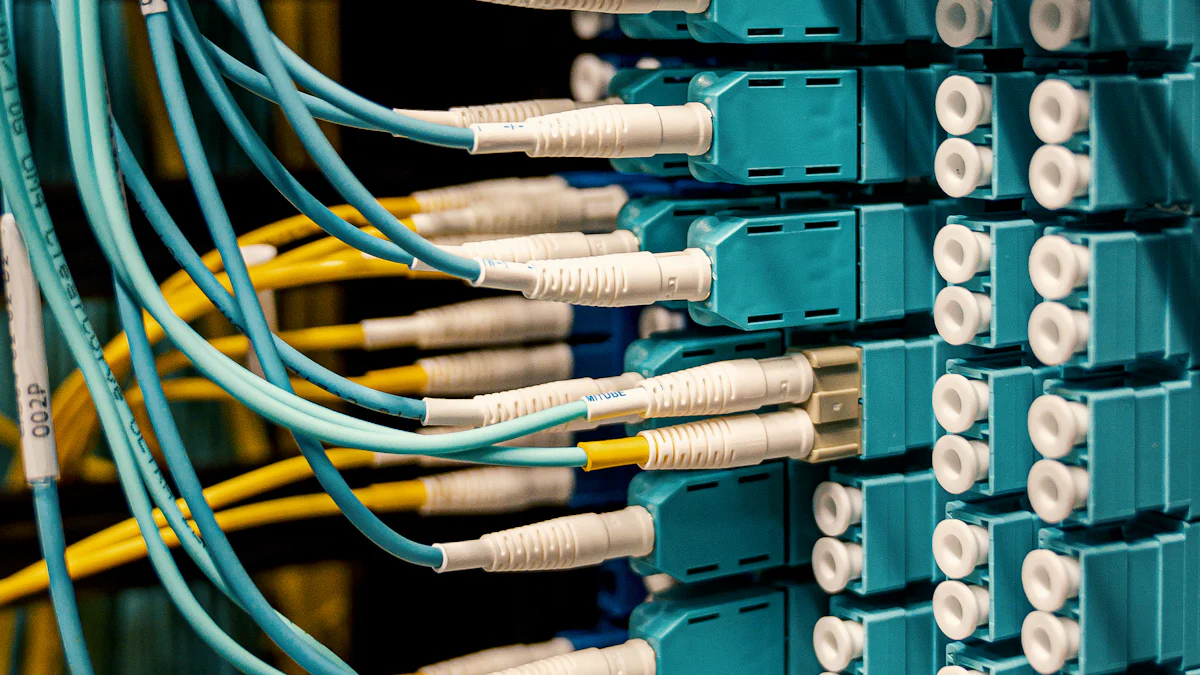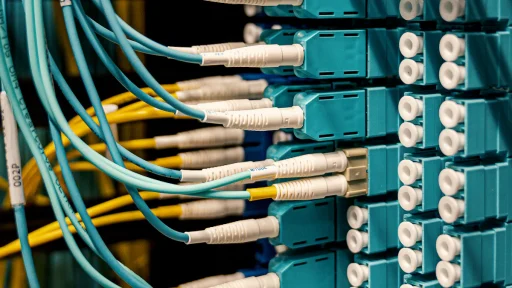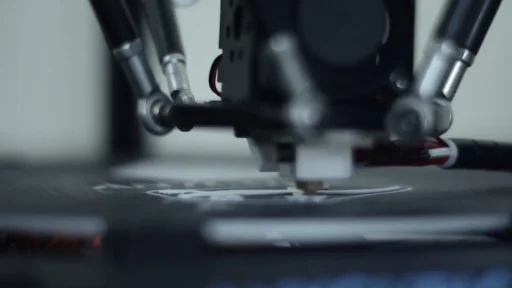

The rise of high-density rack configurations has transformed data centers, pushing the boundaries of performance and efficiency. These configurations, capable of handling up to 50kW per rack, demand innovative solutions to manage the immense heat and energy they generate. Advanced cooling systems, such as liquid cooling, have emerged as essential tools to maintain optimal temperatures. Efficient power distribution ensures uninterrupted operations, while real-time monitoring enhances reliability. By addressing these critical aspects, you can optimize your infrastructure to meet the growing demands of modern computing environments.
Key Takeaways
Implement advanced cooling solutions like liquid cooling and immersion cooling to effectively manage heat in high-density racks, ensuring optimal performance.
Adopt high-efficiency power systems to minimize energy loss and reduce operational costs, contributing to a more sustainable data center environment.
Utilize real-time monitoring tools to track power density and system performance, allowing for immediate corrective actions to prevent overheating and downtime.
Incorporate predictive analytics to forecast potential issues and schedule maintenance proactively, enhancing system reliability and longevity.
Consider redundancy models in power distribution to ensure uninterrupted operations, safeguarding against potential power failures.
Select energy-efficient hardware to lower energy consumption and heat generation, which supports both performance and sustainability goals.
Consolidate workloads in high-density racks to maximize computational power while minimizing physical space and energy requirements.
Understanding High-Density Rack Configurations
Characteristics of High-Density Rack Configurations
High-density systems have redefined how data centers operate, enabling them to handle unprecedented workloads. A high-density rack, capable of supporting up to 50kW rack density, represents a significant leap in computational power. These racks are designed to accommodate advanced hardware, such as GPUs and CPUs, which generate substantial heat during operation. The compact nature of these configurations allows you to maximize floor space while achieving higher performance levels.
Modern high-density computing environments often integrate innovative cooling mechanisms to manage the thermal load effectively. Liquid cooling and immersion cooling are becoming standard solutions for maintaining optimal temperatures. Additionally, these racks require robust power distribution systems to ensure consistent energy delivery. By leveraging these features, you can enhance the efficiency and scalability of your data center architecture.
Challenges of Achieving 50kW Rack Density
Reaching a 50kW rack density presents several challenges that demand careful planning and execution. One of the primary obstacles is managing the immense heat generated by high-density systems. Traditional air cooling methods often fall short, making advanced cooling technologies essential. Without proper heat management, the risk of hardware failure increases significantly.
Power distribution is another critical challenge. High-density racks require efficient and reliable power systems to handle their energy demands. Any disruption in power delivery can lead to downtime, affecting the overall performance of your data center. Furthermore, the integration of these systems into existing data center architectures can be complex, requiring significant infrastructure upgrades.
Lastly, achieving such high rack densities necessitates precise monitoring and analytics. Real-time data on temperature, power usage, and system health is crucial for maintaining stability. Without these insights, optimizing performance and preventing failures becomes nearly impossible.
Infrastructure Requirements for High Power Density
To support a 50kW rack density, your infrastructure must meet specific requirements. Cooling systems play a pivotal role in managing the thermal load. Liquid cooling, direct-to-chip cooling, and immersion cooling are among the most effective solutions for dissipating heat in high-density configurations. These technologies ensure that your systems remain operational even under extreme conditions.
Power distribution systems must also be designed to handle the demands of high-density racks. High-efficiency power units, combined with redundancy models, provide the reliability needed for uninterrupted operations. These systems minimize energy loss and reduce the risk of power-related failures.
Additionally, your data center must incorporate advanced monitoring tools. These tools provide real-time insights into power density, heat levels, and system performance. Predictive analytics can further enhance your ability to address potential issues before they escalate. By investing in these infrastructure components, you can create a robust foundation for high-density computing environments.
Cooling Solutions for 50kW Racks
Efficient cooling is the backbone of high-density rack configurations, especially when managing 50kW power loads. Traditional air-based cooling methods often fail to meet the demands of such systems, making advanced cooling solutions essential. By adopting innovative cooling techniques, you can ensure optimal thermal management, improve system reliability, and maximize performance.
Liquid Cooling for High-Density Racks
Liquid cooling has revolutionized thermal management in high-density data centers. Unlike air cooling, liquid cooling leverages the superior thermal transfer properties of liquids to dissipate heat more effectively. This method enables you to maintain stable operating temperatures even under extreme workloads.
Modern liquid cooling technologies include solutions like rear door heat exchangers and cold plates. Rear door heat exchangers can remove significant amounts of heat directly from the rack, reducing the strain on your overall cooling infrastructure. Cold plates, a key component of direct-to-chip cooling, target specific heat-generating components like CPUs and GPUs, ensuring precise thermal control.
“Water is 24 times more efficient at cooling than air and can hold 3200 times more heat,” as industry experts highlight. This efficiency makes liquid cooling indispensable for high-density environments.
Implementing liquid cooling requires careful planning. You must consider factors like space allocation, infrastructure costs, and system monitoring. However, the benefits—enhanced reliability, reduced energy consumption, and the ability to support higher power densities—far outweigh the challenges.
Direct-to-Chip Cooling for Enhanced Efficiency
Direct-to-chip cooling represents one of the most targeted and efficient cooling solutions available today. This method uses cold plates to transfer heat directly from the chip to a liquid coolant, bypassing the inefficiencies of traditional air cooling. By focusing on the primary heat sources, direct-to-chip cooling can remove up to 80% of a server’s heat.
This approach is particularly beneficial for high-performance computing (HPC) and AI workloads, where heat generation is intense. Direct-to-chip cooling not only ensures thermal stability but also allows you to achieve higher computational densities without compromising system performance.
To integrate direct-to-chip cooling into your data center, you need to evaluate your existing infrastructure. Ensure compatibility with your hardware and plan for the installation of liquid distribution units (LDUs) to manage the flow of coolant. With proper implementation, this method can significantly enhance your cooling efficiency.
Immersion Cooling for Extreme Power Density
Immersion cooling takes thermal management to the next level by submerging servers or components in a dielectric liquid. This liquid acts as both a coolant and an insulator, preventing electrical discharge while efficiently dissipating heat. Immersion cooling is ideal for extreme power densities, making it a perfect fit for 50kW racks.
This method offers several advantages. It eliminates the need for traditional air cooling systems, reduces noise levels, and minimizes energy consumption. Companies like KDDI have demonstrated the effectiveness of immersion cooling, achieving a 43% reduction in power consumption and a Power Usage Effectiveness (PUE) below 1.07.
Immersion cooling also simplifies maintenance. The dielectric liquid protects components from dust and other contaminants, extending their lifespan. However, adopting this technology requires a shift in data center design and operational practices. You must invest in specialized tanks, coolants, and monitoring systems to fully leverage its benefits.
By exploring and implementing these advanced cooling solutions, you can optimize your high-density rack configurations for 50kW power loads. These methods not only address the thermal challenges of modern computing environments but also pave the way for sustainable and scalable data center operations.
Power Distribution Strategies for 50kW Rack Density


Efficient power distribution forms the backbone of high-density rack configurations. When managing 50kW rack density, you must adopt strategies that ensure consistent energy delivery while minimizing waste. By implementing advanced power systems and redundancy models, you can enhance reliability and optimize energy usage in your data centers.
High-Efficiency Power Systems for Data Centers
High-efficiency power systems are essential for supporting the energy demands of 50kW racks. These systems convert electrical input into usable output with minimal energy loss, reducing waste heat and improving overall efficiency. Power supplies with certifications like 80 PLUS exemplify this approach. They deliver more usable power while consuming less electricity, which directly lowers operational costs.
Modern data centers benefit from these systems by achieving better energy utilization. High-efficiency power units also contribute to sustainability by reducing the environmental impact of operations. For example, they help maintain lower cooling requirements since less waste heat is generated. This synergy between power efficiency and thermal management ensures that your infrastructure remains both cost-effective and environmentally responsible.
To integrate high-efficiency power systems, you should evaluate your current setup and identify areas for improvement. Upgrading to energy-efficient hardware and optimizing power distribution pathways can significantly enhance performance. Additionally, monitoring tools can provide real-time insights into energy usage, enabling you to make informed decisions about system upgrades.
Redundancy Models to Ensure Reliability
Reliability is critical when operating high-density racks at 50kW. Any disruption in power delivery can lead to downtime, affecting the performance of your data centers. Redundancy models address this challenge by providing backup systems that ensure uninterrupted operations even during failures.
A common approach involves deploying N+1 redundancy, where an additional power unit supports the primary system. If one unit fails, the backup seamlessly takes over, preventing interruptions. For more robust setups, 2N redundancy offers complete duplication of power systems, ensuring maximum reliability. While this model requires higher investment, it provides unparalleled assurance for mission-critical applications.
Redundancy models also simplify maintenance. You can perform repairs or upgrades on one system without affecting the overall operation. This flexibility minimizes risks and enhances the long-term stability of your infrastructure. To implement redundancy effectively, you should assess your power requirements and choose a model that aligns with your operational goals.
By combining high-efficiency power systems with redundancy models, you can create a resilient and energy-efficient foundation for your high-density racks. These strategies not only optimize power usage but also ensure that your data centers remain reliable and scalable in the face of growing demands.
Energy Efficiency and Sustainability in High-Density Racks
Selecting Energy-Efficient Hardware for 50kW Racks
Choosing the right hardware is essential for achieving energy efficiency in high-density environments. Modern hardware components, such as processors and GPUs, are designed to deliver higher performance while consuming less power. By selecting energy-efficient hardware, you can reduce operational costs and minimize the environmental impact of your data centers.
High-efficiency power supplies play a critical role in supporting 50kW rack configurations. These systems convert electrical energy with minimal loss, ensuring that more power is directed toward operational needs. Certifications like 80 PLUS provide a benchmark for identifying hardware that meets stringent energy efficiency standards. Incorporating such components into your racks not only optimizes energy usage but also reduces heat generation, which eases the burden on cooling systems.
Additionally, advancements in server technology have introduced features like dynamic voltage scaling and power capping. These features allow you to adjust power consumption based on workload demands, further enhancing energy efficiency. For example, servers equipped with these technologies can operate at lower power levels during periods of reduced activity, conserving energy without compromising performance.
When selecting hardware, consider the long-term benefits of energy-efficient options. While the initial investment may be higher, the savings in energy costs and the reduced need for extensive cooling infrastructure make it a worthwhile choice. By prioritizing energy-efficient hardware, you can create a sustainable foundation for your high-density racks.
Operational Practices to Enhance Sustainability
Sustainability in high-density data centers goes beyond hardware selection. Operational practices play a significant role in reducing energy consumption and promoting environmental responsibility. Implementing best practices can help you optimize resource utilization and minimize waste.
Start by adopting intelligent cooling strategies. Advanced cooling methods, such as liquid cooling, are more efficient than traditional air-based systems. Liquid cooling not only manages the heat generated by 50kW racks effectively but also reduces overall energy consumption. For instance, liquid cooling systems can achieve up to 30% energy savings compared to conventional methods, making them a sustainable choice for high-density environments.
Monitoring and analytics tools are indispensable for maintaining sustainability. Real-time monitoring provides insights into power usage, temperature levels, and system performance. These insights enable you to identify inefficiencies and take corrective actions promptly. Predictive analytics can further enhance sustainability by forecasting potential issues and allowing you to address them before they escalate.
Another effective practice involves consolidating workloads. High-density racks allow you to pack more computational power into a smaller space, reducing the need for additional infrastructure. This consolidation not only saves floor space but also lowers energy requirements. For example, transitioning from low-density to high-density configurations can reduce the number of racks needed, leading to significant cost and energy savings.
Finally, consider renewable energy sources to power your data centers. Solar panels, wind turbines, and other renewable options can offset the environmental impact of high-density operations. By integrating renewable energy into your power supply, you can further enhance the sustainability of your infrastructure.
By combining energy-efficient hardware with sustainable operational practices, you can optimize your high-density racks for both performance and environmental responsibility. These efforts not only align with industry trends but also position your data centers as leaders in sustainability.
Monitoring and Analytics for High-Density Rack Configurations
Monitoring and analytics are essential for optimizing high-density rack configurations. They provide you with the tools to ensure operational stability, maximize power density, and maintain system health. By leveraging real-time monitoring and predictive analytics, you can proactively address potential issues and enhance the efficiency of your data centers.
Real-Time Monitoring for Power Density Optimization
Real-time monitoring allows you to track critical metrics like power density, temperature, and energy consumption. These insights help you identify inefficiencies and take immediate corrective actions. For high-density racks operating at 50kW, this level of visibility is crucial to prevent overheating and ensure consistent performance.
Modern monitoring tools, such as Prometheus and Dynatrace, offer advanced capabilities for tracking power density in real time. These tools provide dashboards that display live data, enabling you to make informed decisions quickly. For example, if a cooling system underperforms, real-time monitoring alerts you to the issue before it escalates into a failure.
“Proactive monitoring reduces downtime and improves system availability,” says a Monitoring and Observability Specialist. This approach ensures that your data centers remain reliable even under extreme workloads.
To optimize power density, you should also monitor the performance of your cooling systems. Liquid cooling and immersion cooling, commonly used in high-density environments, require precise temperature control. Real-time data helps you maintain optimal cooling efficiency, which directly impacts the stability of your infrastructure.
Implementing real-time monitoring involves integrating sensors and software into your data center management strategy. These systems collect and analyze data continuously, giving you a comprehensive view of your operations. By adopting this technology, you can enhance the reliability and scalability of your high-density racks.
Predictive Analytics for System Health and Maintenance
Predictive analytics takes monitoring a step further by using historical data to forecast potential issues. This technology helps you anticipate failures and schedule maintenance proactively, reducing the risk of unexpected downtime. For high-density configurations, where power density reaches 50kW, predictive analytics is invaluable for maintaining system health.
Tools like the ELK Stack and Nagios excel at analyzing trends and identifying anomalies. These platforms use machine learning algorithms to detect patterns that indicate potential problems. For instance, a gradual increase in power consumption might signal an impending hardware failure. Addressing such issues early prevents costly disruptions.
Predictive analytics also enhances the efficiency of your cooling systems. By analyzing data from sensors, these tools can predict when cooling components need maintenance or replacement. This foresight ensures that your systems operate at peak performance, even in demanding environments.
“Monitoring the monitoring tools themselves is equally important,” emphasizes the Monitoring and Observability Specialist. Ensuring the accuracy and reliability of your analytics platforms guarantees that you receive actionable insights.
To implement predictive analytics, you need to invest in robust software and train your team to interpret the data effectively. Combining this approach with real-time monitoring creates a comprehensive strategy for managing high-density racks. This dual approach not only optimizes power density but also extends the lifespan of your infrastructure.
By integrating real-time monitoring and predictive analytics into your data center management practices, you can achieve unparalleled efficiency and reliability. These technologies empower you to address challenges proactively, ensuring that your high-density racks perform optimally under any conditions.
Optimizing high-density rack configurations for 50kW power loads is essential for meeting the demands of modern data centers. By adopting innovative cooling methods, you can effectively manage heat and ensure system stability. Efficient power distribution strategies enhance reliability and reduce operational costs. Advanced monitoring tools provide real-time insights, enabling you to maintain peak performance. Proactive planning and the integration of cutting-edge solutions position your infrastructure for future scalability. These efforts not only improve operational efficiency but also support sustainability, ensuring your data centers remain competitive in a rapidly evolving industry.
FAQ
How can you support 100+ kW per rack densities?
Supporting 100+ kW per rack densities requires innovative strategies to address the challenges posed by such extreme power loads. These configurations are becoming increasingly relevant with the rise of AI workloads, which demand high computational power. Hyperscalers and colocation data centers are leading the way in accommodating these densities. To achieve this, you need to focus on advanced cooling systems, such as liquid cooling or immersion cooling, to manage the immense heat generated. Additionally, robust power distribution systems and enhanced security measures are essential for maintaining reliability and ensuring seamless interconnection with edge data centers.
Pro Tip: Start by evaluating your current infrastructure and identifying areas where upgrades are necessary to handle these extreme densities effectively.
What are the best ways to optimize power infrastructure costs for densities exceeding 35kW per rack?
To optimize power infrastructure costs while maintaining reliability and safety for densities exceeding 35kW per rack, you should consider integrating liquid cooling systems. Studies, such as those conducted by engineering teams at Schneider Electric, have shown that liquid cooling can significantly reduce power distribution costs in IT rooms. This approach minimizes energy loss and enhances efficiency, making it a cost-effective solution for high-density environments. Focus on designing your power systems to align with international standards, such as IEC, to ensure compatibility and safety.
Key Takeaway: Liquid cooling not only optimizes costs but also improves system reliability, making it a valuable investment for high-density data centers.
Why is liquid cooling preferred for high-density racks?
Liquid cooling is preferred for high-density racks because it offers superior thermal management compared to traditional air cooling. Liquids have higher thermal conductivity, allowing them to dissipate heat more efficiently. This method is particularly effective for managing the heat generated by 50kW or higher power loads. By using technologies like direct-to-chip cooling or rear door heat exchangers, you can maintain stable operating temperatures and improve system performance.
“Water is 24 times more efficient at cooling than air,” as industry experts emphasize, making liquid cooling indispensable for modern data centers.
How does immersion cooling benefit extreme power densities?
Immersion cooling benefits extreme power densities by submerging servers in a dielectric liquid, which acts as both a coolant and an insulator. This method eliminates the need for traditional air cooling systems and reduces energy consumption. Immersion cooling is ideal for configurations exceeding 50kW per rack, as it efficiently manages heat while minimizing noise and maintenance requirements. Companies adopting this technology have reported significant energy savings and improved system reliability.
Did You Know? Immersion cooling can achieve a Power Usage Effectiveness (PUE) below 1.07, making it one of the most sustainable cooling solutions available.
What role does real-time monitoring play in high-density rack configurations?
Real-time monitoring plays a critical role in optimizing high-density rack configurations. It provides you with actionable insights into power usage, temperature levels, and system performance. By tracking these metrics, you can identify inefficiencies and address potential issues before they escalate. For racks operating at 50kW or higher, real-time monitoring ensures consistent performance and prevents overheating.
Expert Insight: Proactive monitoring reduces downtime and enhances system availability, making it an essential tool for managing high-density data centers.
How can predictive analytics improve system health in high-density environments?
Predictive analytics improves system health by using historical data to forecast potential failures. This technology helps you schedule maintenance proactively, reducing the risk of unexpected downtime. For high-density environments, predictive analytics can identify patterns in power consumption or cooling performance, allowing you to address issues before they impact operations. By combining predictive analytics with real-time monitoring, you can create a comprehensive strategy for maintaining system reliability.
Tip: Invest in robust analytics tools and train your team to interpret data effectively for maximum benefits.
What are the key considerations for integrating renewable energy into high-density data centers?
Integrating renewable energy into high-density data centers involves evaluating your power requirements and identifying suitable renewable sources, such as solar or wind energy. Renewable energy can offset the environmental impact of high-density operations and enhance sustainability. To maximize efficiency, you should also consider energy storage solutions, like batteries, to ensure a consistent power supply during periods of low renewable energy generation.
Sustainability Tip: Combining renewable energy with energy-efficient hardware and cooling systems creates a greener and more cost-effective data center.
How can you ensure reliability in power distribution for 50kW racks?
Ensuring reliability in power distribution for 50kW racks requires implementing redundancy models. N+1 redundancy provides an additional power unit to support the primary system, while 2N redundancy offers complete duplication for maximum reliability. These models prevent downtime by seamlessly transferring operations to backup systems during failures. Regular maintenance and real-time monitoring further enhance the reliability of your power distribution infrastructure.
Best Practice: Choose a redundancy model that aligns with your operational goals and budget to maintain uninterrupted operations.
What are the advantages of consolidating workloads in high-density racks?
Consolidating workloads in high-density racks allows you to maximize computational power while minimizing physical space requirements. This approach reduces the number of racks needed, lowering energy consumption and operational costs. High-density configurations also simplify infrastructure management, making it easier to monitor and maintain systems. By consolidating workloads, you can achieve greater efficiency and scalability in your data center operations.
Efficiency Insight: Transitioning from low-density to high-density configurations can lead to significant cost and energy savings.
How do advanced cooling methods contribute to sustainability in data centers?
Advanced cooling methods, such as liquid cooling and immersion cooling, contribute to sustainability by reducing energy consumption and improving thermal efficiency. These systems manage the heat generated by high-density racks more effectively than traditional air cooling, resulting in lower operational costs and a smaller carbon footprint. By adopting these technologies, you can align your data center operations with environmental goals while maintaining high performance.
Green Tip: Implementing advanced cooling solutions is a step toward creating sustainable and future-ready data centers.






